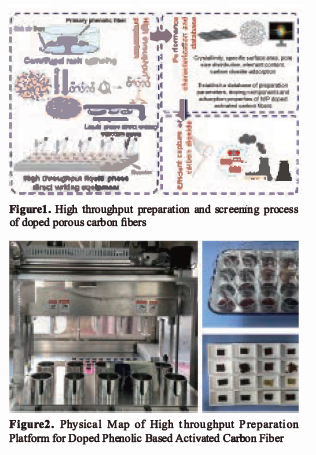Yufei Gao1, Mingyi Chen1,2, Yuan Zeng1,4, Jian Zhu1, Liang Wang2*, Rouxi Chen1,3*, Hsing-Lin Wang1*
1Departinent of materials science and engineering, Southern University of Science and Southern Universityof Science and Technology, Shenzhen, Guangdong, 518055, China
2School of Textiles Science and Engineering, Tiangong University, Tianjin, Tianjin, 300387, China.
3Academy for Advanced Interdisciplinary Studies, Southern University of Science and Technology,Shenzhen, Guangdong, 518055, China
4Taizhou Research Institute of Southern University of Science and Technology, Taizhou, 318001, China
EXTENDED ABSTRACT: Under the national strategic background of "carbon peaking" and "carbon neutralization", how to efficiently capture, store and utilize carbon dioxide has become a social focus. Carbon dioxide capture tec加ologies such as physical adsorption, chemical absorption, membrane separation [ 1] have also received extensive attention. Among them, physical adsorption technology is widely used because of its low energy consumption, simple and convenient operation. As a highly efficient CO2 adsorption material, activated carbon fiber with high specific surface area is also one of the research focuses in recent years. Based on the idea of material genetic engineering, this research has built a high-throughput preparation platform for phenolic based porous carbon fibers, which can realize continuous and variable doping of multiple components. Combining high-throughput characterization technology, the physicochemical properties and carbon dioxide adsorption properties of phenolic based porous carbon fibers doped with continuous and variable components are obtained. The porous carbon fiber materials with the best carbondioxide adsorption performance were rapidly screened out. In the high-throughput preparation.we prepared phenolic fiber with certain mechanical strength from thermosetting phenolicresin through melt centrifugal spinning and impregnation crosslinking process, which is usedas the precursor of carbon fiber; Then, different proportions of N and P dopants (nitrogen dopants: urea, melamine, etc, phosphorus dopants: red phosphorus, triphenylphosphine, etc.)and pore forming agent (KOH) are prepared into doping activation solution through high-throughput liquid phase direct writing equipment, and phenolic fiber precursor is immersedin the activation solution for high-temperature activation and carbonization in inert gas atmosphere, finally obtaining N/P doped activated carbon fibers with different morphology and performance. In the performance characterization, Raman, SEM, BET,XRD, XPS,CO2 adsorption and other characterization and testing methods were used to obtain the physical and chemical properties of N/P doped activated carbon fibers with different proportions, such as microstructure, pore size distribution, specific surface area, CO2 adsorption, etc., and the series of data were collected into the database of N/P doped activated carbon fibers' preparation parameters - doping components - adsorption properties. At present, we can realize the high-throughput preparation of 20 groups of different N/P doped activated carbon fibers in each batch. The specific surface area of the optimal activated carbon fiber samples screened by the carbon fiber material composition adsorption performance database can reach 2253.06m2/g, the CO2 adsorption capacity at room temperature and pressure can reach 4.91mmol/g, and the CO2 adsorption capacity at 273K can reach 6.98mmol/g.
REFERENCES
[I] D"Alessandro D, Smit B, Long J, Angewandte Chem ie International Edition, 49(35),20106058-6082;
[2] Zheng F, Yang Y, Chen Q, Nature Comm unications, 5, (2014) 1-10;
[3] Yu P., Zhang W., Liu Y, Carbon, 3, (2021) 100-108


Rouxi Chen , Ph.D, Associate Professor and Associate Researcher of the Department of Materials Science and Engineering and the Research Institute of Frontier and Cross cutting Sciences of Southern University of Science and Technology, Master's Supervisor, Doctor of the School of Textile and Clothing Engineering of Suzhou University, Advanced Fiber Materials Laboratory of the School of Materials of the University of British Columbia (UBC), Canada, and Post doctoral candidate of South China University of Technology. Her research field mainly focuses on the preparation mechanism and application research of functional nanofibers. In recent years, she has been committed to developing a high-throughput preparation platform for functional nanofibers based on the idea of material gene, and has carried out its applications in nuclear power military industry, environmental filtration, special protection, medical dressing and energy batteries. Relevant research achievements have published more than 30 academic papers and applied for more than 30 patents.